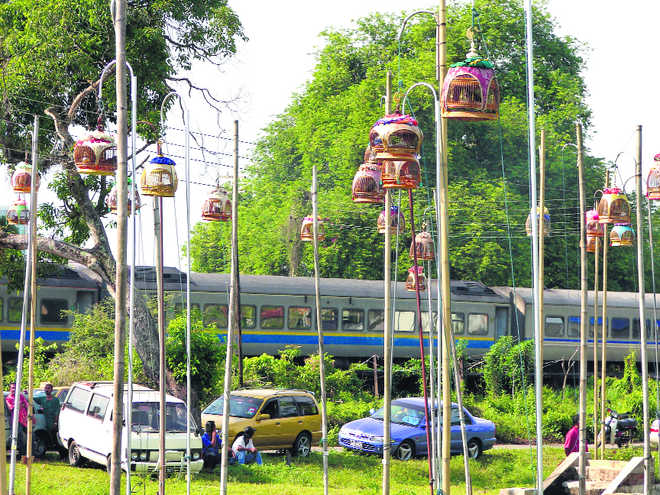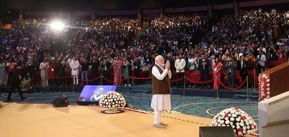
A melodic break: Poles erected for the singing birds competition
Hugh and Colleen Gantzer
Some birds sing for their suppers. Others get apartments for soup. From our hotel window, Kota Bharu spread below us, rising in the forested coastal lands of the South China Sea. Significantly Islamic, it had no cinemas but it had other delightful diversions. On a field between a highway and the rail tracks, 91 tall poles had been erected. Each pole had a hook at the end; and from each hook a beautiful cage was hanging. Men walked around below the poles, listening carefully and making notes. This was a Friday Singing Bird Contest for greatly loved doves. On the far side of the field, their owners waited near their cars, watching the judges anxiously.
Leaving the cooing-connoisseurs, we drove on to Malaysia’s riverine border with Thailand. Here, the Thai influence is strong: Buddhist temples soared, glittering with crimson, gold and blue. Dragons raised their scaly heads in one wat fashioned like a traditional dragon boat. Another featured a statue of the Chinese goddess Kuan Yin and a series of icons that bore a strong resemblance to deities in the Hindu pantheon. In the grounds of most of the wats, crowds of festive Malaysians relaxed on their weekly holiday, shopping and snacking. The Chinese and Indian Malaysian girls wore mini-skirts or jeans, their Muslim Malay friends donned distinguishing headscarves. Here truly, were the myriad ethnic colours of Malaysia.
Among their most colourful creations are their kites that resemble enormous butterflies. Their silver handicrafts, including silver tea sets and the traditional Malay daggers, are also beautifully made and worth looking at. A special type of batik is made of real leaves to give outlines that make every piece unique. Customers can specify the leaves they want.
There is plenty of foliage to choose from, as we discovered when we drove down shaded roads to a rural jetty. We boarded a boat for a cruise down a café-au-lait river to its confluence with the sea. Women and children, some shaded with umbrellas, filled other brightly painted boats to the gunnels. Then the rainforest closed in. There was the dank and mushroom smell of loam. In the humidity, sweat began to pour off us. Something scaly slid off the wet banks and into the water: it could have been a monitor lizard. Surf grinned white in the distance and our boat bobbed with the swell. We did a u-turn and headed back to visit a market rich with the aroma of fresh fruit.
In the Siti Khadijah Market, friendly women encouraged us to taste exotic, orchard fresh, products. The crimson dragon fruit, with its blood-red flesh, is delicious: it grows on an intriguing cactus creeper. Then there’s the mangosteen, the durian …smelly but ambrosial …the Pulasan which looks like a very knobbly lichee, and a really sweet Tamarind.
Markets, particularly those with open-fronted stalls, capture the present-day flavour of a people’s culture. A deeper appreciation of their roots can be found in their museums. In Kota Bharu, many museums stand around Padang Merdeka or Independence Square. The Istana Batu was a lived-in palace and its dining room and bedrooms show how much the Malay Sultans were influenced by British traditions, as indeed our ruling princes were. There is, for instance, an interesting artificial Christmas tree, though Islam does not celebrate Christmas! The Istana Jaharshould really be described as the Palace of the Royal Rites of Passage like circumcisions and the ceremonies connected with the critical seventh month of pregnancy. The Muzium Negeri or State Museum has an impressive mock-up of a prehistoric cave. We were intrigued by its claim that its Rehab was the ‘ancestor of the present day violin’.In the Sarod Museum, in Gwalior, we learnt that the Rahab was brought to India from Afghanistan. Clearly, this is a stringed instrument associated with Islamic musical traditions, globally.
And if you hear the musical twittering of swifts, these are recordings to entice these birds to build their edible nests in the attics of town houses. When they leave their apartments, every year, their nests are harvested for the very expensive Birds’ Nest Soup. Soup is the rent they pay for their annual accommodation in Kota Bharu.



























